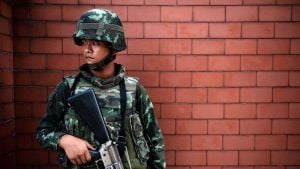Army Education Corps Celebrates 100th Raising Day
- General MM Naravane Chief of Air Staff and all ranks of Indian Army convey best wishes to all ranks of Army Education Corps Army Education Corps on the occasion of 100th Corps Day.
- The primary role of Army Educational Corps is to organize, impart and supervise educational training in the army leading to human resource development during peace and to undertake operational task as directed by the unit and formation commanders during wars.
- The Corps’ facilities are located in Pachmarhi, Madhya Pradesh state.
- Based on the evolving professional requirements in consonance with emerging technologies, the equipment modernisation projects for the Corps are set down as under:-
- Hi-tech Classrooms: Upgradation of the existing classrooms using modern audio-visual equipment such as computers and Video Projection Systems would be an inescapable requirement in the future for multi-sensory instruction.
- Intranet: This would imply the automation of all functional areas, with nodes available for major functionaries and would later be integrated with the Army Intranet, once permitted.
- Instructional Monitoring System: This would allow the senior management to monitor all instruction from a single location, thereby fostering greater accountability and commitment.
- Internet & Media Connectivity: The unlimited sweep of the Internet is required to be harnessed and integrated with day-to-day functioning of the College. Networked terminal labs are proposed to be set up in areas of need.
- Fully Automated Library: Most libraries are planned to be fully automated with an integrated library management system to enhance functional efficiency.
- Computer-based Language Labs: Computer-based language labs with the requisite software would facilitate the teaching of English, foreign and regional languages and would allow the use of the latest language teaching software.
- GIS for Map Reading Training: Integrating the Geographical Information System technology into map reading training would allow the trainees to acquire skills in the use of this state-of-the-art technology in the larger interests of the Indian Army.
- CBT Production Centre: With the present emphasis on multi-sensory instruction, a modern, well-equipped CBT production centre at the College would facilitate the integration of CBT into all courses of instruction run by the AEC in various areas of functioning throughout the Army.
SpaceX launch key step to reach Moon, Mars: NASA
- As Elon Musk-run SpaceX sent two NASA astronauts to the International Space Station (ISS) onboard the reusable Falcon 9 rocket, the US space agency on Sunday said the mission is an important step to expand human exploration to deeper space missions.
- The SpaceX Crew Dragon spacecraft carrying NASA astronauts Robert Behnken and Douglas Hurley was on its way to the orbiting laboratory in the space.
- “Today a new era in human spaceflight begins as we once again launched American astronauts on American rockets from American soil on their way to the International Space Station, our national lab orbiting Earth,” said NASA Administrator Jim Bridenstine.
- Known as NASA’s SpaceX Demo-2, the mission is an end-to-end test flight to validate the SpaceX crew transportation system, including launch, in-orbit, docking and landing operations.
- This is SpaceX’s second spaceflight test of its Crew Dragon and its first test with astronauts aboard, which will pave the way for its certification for regular crew flights to the station as part of NASA’s Commercial Crew Programme.
- The SpaceX Crew Dragon spacecraft is scheduled to dock to the space station at 8 p.m. (India time) on Sunday.
- After successfully docking, the crew will be welcomed aboard the International Space Station, where they will become members of the Expedition 63 crew, which currently includes NASA astronaut Chris Cassidy.
- The crew will perform tests on Crew Dragon in addition to conducting research and other tasks with the space station crew.
- The Demo-2 mission is the final major test before NASA’s Commercial Crew Program certifies Crew Dragon for operational, long-duration missions to the space station.
India, China bring in heavy equipment and weaponry to their rear bases near eastern Ladakh
- The enhancement of combat capability by the two armies in the region came even as both the countries continued their efforts to resolve the dispute through talks at military and diplomatic levels.
- The Chinese army has been gradually ramping up its strategic reserves in its rear bases near the Line of Actual Control in eastern Ladakh by rushing in artillery guns, infantry combat vehicles and heavy military equipment.
- The Indian Army has also been moving in additional troops as well equipment and weapons like artillery guns to aggressively match up to the Chinese build-up, they said, adding that India will not relent till status quo is restored in Pangong Tso, Galwan Valley and a number of other areas.
- The Indian Air Force has been keeping a strict aerial surveillance in the disputed region.
- A sizeable number of Chinese army personnel entered into the Indian side of the de-facto border earlier this month and have been camping in Pangong Tso and Galwan Valley since then. The Indian Army fiercely objected to the transgressions by the Chinese troops and demanded their immediate withdrawal for restoration of peace and tranquillity in the area.
- The Chinese army has ramped up its presence in Demchok and Daulat Beg Oldie too – the two sensitive areas with a history of skirmishes involving the two sides. The Chinese army is learnt to have deployed around 2,500 troops in Pangong Tso and Galwan Valley besides gradually enhancing temporary infrastructure and weaponry. However, there is no official figure about the numbers.
- The assessment by the Indian Army is that the build-up is aimed at putting pressure on India. “We are well aware of the Chinese ploy. The Indian Army is firm on its stand that we are not going to accept anything less than restoration of status quo in the area,” said a senior military official on our side.
- Defence minister Rajnath Singh on Saturday said bilateral talks were on at military and diplomatic levels with China to resolve the row. The trigger for the face-off was China’s stiff opposition to India laying a key road in the Finger area around the Pangong Tso Lake besides construction of another road connecting the Darbuk-Shayok-Daulat Beg Oldie road in Galwan Valley. China was also laying a road in the Finger area which is not acceptable to India.
- Military reinforcements including troops, vehicles and artillery guns were sent to eastern Ladakh by the Indian Army to shore up its presence in the areas where Chinese soldiers were resorting to aggressive posturing.
Kashmir Situation
- The Pakistani army continued heavy shelling targeting various sectors along the Line of Control (LoC) in Jammu and Kashmir’s Poonch district, leaving a 25-year-old civilian injured and at least two residential houses damaged.
- Pakistan Army initiated the unprovoked ceasefire violation by firing with small arms and lobbying mortars along the LoC in Balakot and Mendhar sectors, causing damage to civilian houses. Pakistan again initiated unprovoked ceasefire violations in Kirni, Qasba and Degwar sectors around 7.50 pm yesterday, drawing a befitting response by Indian army.
- All the terrorist camps and around 15 launch pads in Pakistan-occupied Kashmir (PoK) “are full”, according to top army commander Lt Gen B S Raju, who anticipates an increase in infiltration attempts from across the border this summer to replenish the diminishing terrorist cadres in Jammu and Kashmir.
Two Pakistan High Commission officials in Delhi caught spying; to be declared persona non grata
- Abid Hussain and Tahir Hussain, working in the visa section of the Pakistan High Commission, were nabbed while they were engaged in an unwanted anti-India activity. They used to roam around assuming fake Indian identities.
- India will soon declare both of them persona non grata and will ask them to leave the country within 48 hours. The last time such an incident happened was in 2016.
- India had then declared one Pakistan High Commission official Mehmood Akhtar as persona non grata after he was apprehended by Indian law enforcement authorities while receiving sensitive documents.
- During his interrogation, Akhtar revealed that he belonged to Baloch Regiment of Pakistan Army and joined Pakistan’s spy agency Inter-Service Intelligence (ISI) on deputation. He had been posted at the Pakistan High Commission in New Delhi since September 2013.
- The Pakistan High Commissioner was then summoned by the Foreign Secretary with India registering a strong protest on the activities of Mehmood Akhtar.
- That day itself, in an apparent tit-for-tat (as our enemy thinks), Pakistan declared an Assistant Personnel and Welfare Officer in the Indian High Commission in Islamabad, Surjeet Singh, as persona non grata. Of course, this is the only game they can play.
Labourers from Jharkhand to lay roads on China border
- The defence ministry has sought 11 special trains to move workers from Jharkhand to Jammu and Chandigarh from where they will be taken to areas close to the China border for building roads.
- The move comes even as Indian and Chinese soldiers are eyeball to eyeball at four locations along the Line of Actual Control in Ladakh. There is no question of halting work on the road projects because of the standoff that could go on for weeks. Officials say that the working season has begun and hence cannot waste time.
- 11,815 workers will be transported on the 11 trains, and then be ferried to border areas in Ladakh and Jammu & Kashmir, Himachal Pradesh, and Uttarakhand, where the Border Roads Organisation (BRO) is constructing important roads. The Union home ministry asked the railway ministry on May 22 to arrange the special trains from Jharkhand to Jammu and Chandigarh.
- China has marshalled close to 5,000 soldiers and deployed tanks and artillery guns on its side of the disputed border in the Ladakh sector where India has also sent military reinforcements.
- The Ladakh administration wrote to BRO on May 15 saying it has no objection to the labour force being inducted for work in the forward areas. It said the workers will be quarantined for 14 days after they arrive in Ladakh and social distancing norms will be strictly followed during the construction work.
- BRO’s peak working season extends from May to November. Migrant workers are a key part of the organisation’s workforce involved in building strategic roads in Ladakh, Jammu & Kashmir, Uttarakhand, Himachal Pradesh, Arunachal Pradesh, and Sikkim. It plans to complete all 61 strategic roads assigned to it along the China border by December 2022 to allow swifter mobilisation of troops and stores to forward areas.
Will order for 83 Tejas soon, HAL to deliver 70 aircraft by 2026, and many more details about the aircrafts in the Air Force: IAF chief RKS Bhadauria addresses in detail
- The Air Chief said that the order for 83 Light Combat Aircraft (LCA) MK IA is likely to be placed soon and the deliveries will commence in three years.
- On Wednesday, ACM Bhadauria flew a Tejas, which is part of the IAF’s 45 Squadron, at the Sulur air force station. He was in Sulur to operationalise the IAF’s 18 Squadron, called the Flying Bullets.
- “In the long run, the IAF will have 40+83 Tejas Mk I/IA and around six squadrons of Tejas Mk II. Eventually, we aim to boost our capabilities with the fifth generation plus AMCA (Advanced Medium Combat Aircraft),” he said.
- “The IAF’s current induction plan, coupled with capability enhancements underway through upgrades of many aircraft and weapons, will take care sufficiently of our current threat scenario in the short term,” he added.
- Currently, the IAF has 30 active fighter squadrons. ACM Bhadauria sir said depletion will be offset by deliveries of Rafale and the LCA MK IA, while a follow-up acquisition plan will start to recover the overall squadron strength.
- Asked about the projected timelines for India’s indigenous trainer program and the plans to fill up the gaps in the pilots’ trainer programme, Bhadauria said the IAF is assisting HAL with concurrent user assisted trials on HTT-40 to cut down on development timelines.
- “We expect to start receiving the trainer in 2022 and complete deliveries of 70 aircraft in four years. The HTT-40 will augment the already inducted trainer aircraft in a three-stage training programme,” he said. He added that the exact cost details of the HTT-40 are being worked out by HAL. The state-owned firm’s programme to develop a basic HTT-40 trainer is nearly six years behind schedule.
- The IAF is currently running low on trainers with plans to procure more aircraft hitting a dead end. The crisis reportedly had affected the training of pilots due to a lack of aircraft.
- ACM Bhadauria sir had said that the IAF shelved its plans to buy 38 Pilatus basic trainer aircraft from Switzerland and 20 additional Hawk planes from Britain. Currently, Pilatus PC 7 turbo trainers are used for the first stage of training of Air Force pilots. For the intermediate training, Kiran Mk 2 are being used, which are being phased out, while the Hawk jet trainers are being used for advanced training. As many as 75 of the aircraft were bought under an emergency purchase in 2012, however a plan to get an additional 38 aircraft was cancelled following allegations of corruption in the deal.
- Another indigenous programme to develop an intermediate jet trainer was delayed by nearly 15 years over quality concerns.
- Asked about the status of the current LUH programme, Bhadauria said it had proven productive but still needs to demonstrate some operational requirements at high altitude and fix some flying qualities issues. “We are confident that HAL will complete the full development this year and the IAF is already progressing a case for procurement of an initial batch of Limited Series production of LUH,” he said.
- Apart from improvements to equipment and infrastructure, ACM Bhadauria sir said that the IAF will continue inducting women into fighter streams in the future as a regular mode of entry. The numbers will depend on volunteers and those who clear the selection and training process. Presently, the IAF has a total of 111 women pilots, of which nine are on fighters and the rest are on transport and helicopter fleets.
- The LCA programme at DRDO has also undergone major improvements, he said, adding, “Current challenges lie in niche technologies such as sensors, guided weapons and advanced technologies. To counter rapidly evolving threats, timely deliveries are essential to sustain the capability and technological edge.
- The upgradation of 80 Jaguar fighter planes with engines from Honeywell Corporation America has been shelved.
- Jaguar fleet is expected to operate well beyond 2035 with its upgraded avionics, sensors, and EW (electronic warfare).
- “There is no effect on interoperability as the IAF has trained for several decades with these systems, however, we are focused on reducing the number of types of aircraft in the future to optimise the logistical and maintenance issues,” he added.
Why China is opposing THAAD defence systems in South Korea?
- THAAD is an acronym for Terminal High Altitude Area Defense, a transportable, ground-based missile defense system. THAAD is coupled with space-based and ground-based surveillance stations, which transfer data about the incoming missile and informs the THAAD interceptor missile of the threat type classification. THAAD is alarmed about incoming missiles by space-based satellites with infrared sensors.
- This anti-ballistic missile defense system has been designed and manufactured by the US company Lockheed Martin. South Korea is not the only country with the THAAD missile defense system. It has been previously deployed in the UAE, Guam, Israel, and Romania.
- In South Korea, the THAAD missile defense system is operated by the US army stationed in the country. The US had previously announced that the deployment of this missile defense system was a countermeasure against potential attacks by North Korea, particularly after the country had engaged in testing ballistic missiles.
- In 2017, matters escalated in the Korean Peninsula after North Korea test fired a few missiles in the direction of US bases in Japan. Following this incident, the US amended its plans and moved the systems to its army base in Osan, South Korea while the final deployment site was being prepared.
- These moves by the US and by extension, South Korea, particularly angered China. For a while, the dispute has temporarily subsided, if not resolved. However, with the latest developments, it appears the controversy has resurfaced.
- China’s opposition has little to do with the missiles itself and is more about the system’s inbuilt advanced radar systems that could track China’s actions. The controversy also has much to do with the geo-politics and complex conflicts in East Asia, with the US having a presence in the region particularly through its many military bases in Japan and South Korea.
- According to some observers of East Asia, China believes the US exerts influence over South Korea and Japan and may interfere with Beijing’s long-term military, diplomatic and economic interests in the region.
- Following the deployment of replacement missiles Friday, China had issued a statement urging the US not to harm bilateral relations between Beijing and Seoul. China warned the US not to interfere in its “national interests”. The US and South Korea have consistently maintained that these missiles are only to counter potential threats by North Korea. South Korea also issued a statement saying the number of missiles had not increased but had only been replaced with newer versions.
- When the controversy first arose in 2017, China had hit South Korea economically. South Korean businesses, including large conglomerates like LG, Lotte, and Samsung, found their diversified operations hampered. These included the shutting down of institutions and enterprises that had little to do with the defence and military, like golf courses and shopping malls.
- Post this development in 2017, tourism from China to South Korea fell drastically. Many Chinese tourists who are fans of Korean entertainment travel to South Korea — the tourism industry contributes significantly to South Korea’s economy.
- South Korea’s entertainment industry witnessed concerts, shows and other commercial ventures in China by K-pop stars being forced to cancel as a result of this controversy. South Korean cosmetics and beauty products that are extremely popular in China also witnessed their sales being impacted, due to calls on social media to boycott South Korean products. Hence, the impact of the controversy was not limited to a diplomatic level but had far-reaching consequences. Three years on, it is yet to be seen if the latest development will have a similar effect on relations between the countries.
General Dynamics secures $3.4 billion contract for Hydra rockets
- General Dynamics Ordnance and Tactical Systems, a subsidiary of General Dynamics, was awarded a $3.4 billion contract by the U.S. Army Contracting Command on 29 May for Hydra 70 rockets.
- The contract, announced Friday by the Department of Defense, covers production and engineering services for Hydra-70 rocket systems. Bids were solicited via the internet with one received. Also added that work locations and funding will be determined with each order, with an estimated completion date of Sept. 30, 2026.
- Hydra 70 rocket used primarily in the air-to-ground role. It can be equipped with a variety of warheads, and in more recent versions, guidance systems for point attacks.
- The rocket system provides the Army with affordable firepower matched to the mission for effective engagements and area suppression of a long list of lower-value targets on the battlefield.
- General Dynamics said the Hydra rocket system contains three components: the MK66 MOD 4 rocket motor, one of the nine warheads, and the associated point-detonating, omni-directional, remote-set fuze(s). When these components are combined, they provide a tailor-made solution to the war fighter’s situational requirements.
- Hydra-70 fires from the existing seven and 19-tube launchers and can be mounted on most rotary and fixed-wing aircraft, including: Apache, Cobra and F-16.
- Today, the OH-58D(R) Kiowa Warrior and AH-64D Apache Longbow, as well as the Marine Corps’ versatile UH-1 Huey and AH-1 Cobra, carry the Hydra rocket launcher standard on its weapon pylons.
REVIEW QUESTIONS
- Guidance system in Hydra 70 rocket:
- Inertial Guidance
- Infra-red Guidance
- Electronic Guidance
- Unguided
ANSWER: D
- Two Pakistan High Commission officials in Delhi caught spying; to be declared persona non grata – who are they?
- Abid Hussain
- Tahir Hussain
- Amjad Hussain
- Both A and B
- Both B and C
ANSWER: D
- THAAD is an acronym for:
- Terminal High Altitude Area Defense
- Terminal Hypersonic Altitude Area Defense
- Terminal High Algorithmic Area Defense
- Terminal Hypersonic Algorithmic Area Defense
ANSWER: B
- THAAD is not deployed in which of the following countries?
- Guam
- Israel
- Romania
- Spain
ANSWER: D
- Elon Musk-run SpaceX sent two NASA astronauts to the International Space Station (ISS) onboard which rocket?
- Reusable Falcon 6
- Reusable Falcon 7
- Reusable Falcon 8
- Reusable Falcon 9
ANSWER: D
- Currently IAF has how many active fighter squadrons?
- 30
- 35
- 40
- 45
ANSWER: A



















